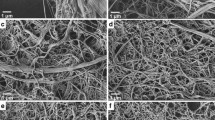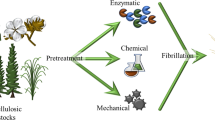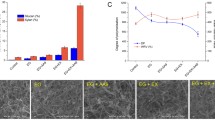Abstract
The low reactivity of lignocellulose limits the effective chemical conversion of lignocellulose biomass into functional bioproducts. Mechanical micro-fibrillation treatment can improve the chemical accessibility of lignocellulose but usually has limited productivity by the low processing solids content. The presented work demonstrates effective micro-fibrillation of lignocellulose at high solids content up to 60 wt% can be achieved by twin-screw extrusion. Morphological characterizations of the extruded wood pulp lignocellulose show the degree of micro-fibrillation is enhanced by operating at higher solids content. The lignocellulose treated at 60 wt% solids content presents 2.1 and 4.8 times higher water retention capacity and specific surface area, respectively, than the original material. Acetylation results show the twin-screw extrusion pre-treatment can significantly accelerate the chemical modification of lignocellulose by 50%. This high productivity method for micro-fibrillating lignocellulose should be of great interest to the bioplastics industry.









Similar content being viewed by others
References
Isikgor FH, Becer CR (2015) Lignocellulosic biomass: a sustainable platform for the production of bio-based chemicals and polymers. Polym Chem 6:4497–4559
Brodin M, Vallejos M, Opedal MT et al (2017) Lignocellulosics as sustainable resources for production of bioplastics—a review. J Clean Prod 162:646–664
Ten E, Vermerris W (2013) Functionalized polymers from lignocellulosic biomass: state of the art. Polymers (Basel) 5:600–642
Chen J, Tang C, Yue Y et al (2017) Highly translucent all wood plastics via heterogeneous esterification in ionic liquid/dimethyl sulfoxide. Ind Crops Prod 108:286–294
Chen MJ, Li RM, Zhang XQ et al (2017) Homogeneous transesterification of sugar cane bagasse toward sustainable plastics. ACS Sustain Chem Eng 5:360–366
Zhen L, Zhang G, Huang K et al (2016) Modification of rice straw for good thermoplasticity via graft copolymerization of ε—caprolactone onto acetylated rice straw using ultrasonic-microwave coassisted technology. ACS Sustain Chem Eng 4:957–964
Bao L, Zou X, Chi S et al (2018) Advanced sustainable thermoplastics based on wood residue using interface nanomodification technique. Adv Sustain Syst 1800050:1–12
Tian SQ, Zhao RY, Chen ZC (2018) Review of the pretreatment and bioconversion of lignocellulosic biomass from wheat straw materials. Renew Sustain Energy Rev 91:483–489
Lee SH, Teramoto Y, Endo T (2010) Enhancement of enzymatic accessibility by fibrillation of woody biomass using batch-type kneader with twin-screw elements. Bioresour Technol 101:769–774
Hoeger IC, Nair SS, Ragauskas AJ et al (2013) Mechanical deconstruction of lignocellulose cell walls and their enzymatic saccharification. Cellulose 20:807–818
Duque A, Manzanares P, Ballesteros M (2017) Extrusion as a pretreatment for lignocellulosic biomass: Fundamentals and applications. Renew Energy 114:1427–1441
Lee SH, Teramoto Y, Endo T (2009) Enzymatic saccharification of woody biomass micro/nanofibrillated by continuous extrusion process I—effect of additives with cellulose affinity. Bioresour Technol 100:275–279
Leu S-Y, Zhu JY (2013) Substrate-related factors affecting enzymatic saccharification of lignocelluloses: our recent understanding. Bioenergy Res 6:405–415
Kumar AK, Sharma S (2017) Recent updates on different methods of pretreatment of lignocellulosic feedstocks: a review. Bioresour Bioprocess 4:7
Zheng J, Rehmann L (2014) Extrusion pretreatment of lignocellulosic biomass: a review. Int J Mol Sci 15:18967–18984
Kratky L, Jirout T (2011) Biomass size reduction machines for enhancing biogas production. Chem Eng Technol 34:391–399
Chen X, Kuhn E, Wang W et al (2013) Comparison of different mechanical refining technologies on the enzymatic digestibility of low severity acid pretreated corn stover. Bioresour Technol 147:401–408
Baati R, Magnin A, Boufi S (2017) High solid content production of nanofibrillar cellulose via continuous extrusion. ACS Sustain Chem Eng 5:2350–2359
Rol F, Karakashov B, Nechyporchuk O et al (2017) Pilot-scale twin screw extrusion and chemical pretreatment as an energy-efficient method for the production of nanofibrillated cellulose at high solid content. ACS Sustain Chem Eng 5:6524–6531
Ho TTT, Abe K, Zimmermann T, Yano H (2015) Nanofibrillation of pulp fibers by twin-screw extrusion. Cellulose 22:421–433
Choi CH, Kim JS, Oh KK (2013) Evaluation the efficacy of extrusion pretreatment via enzymatic digestibility and simultaneous saccharification &fermentation with rapeseed straw. Biomass Bioenerg 54:211–218
Choi CH, Oh KK (2012) Application of a continuous twin screw-driven process for dilute acid pretreatment of rape straw. Bioresour Technol 110:349–354
Um BH, Choi CH, Oh KK (2013) Chemicals effect on the enzymatic digestibility of rape straw over the thermo-mechanical pretreatment using a continuous twin screw-driven reactor (CTSR). Bioresour Technol 130:38–44
da Silva AS, Teixeira RSS, Endo T et al (2013) Continuous pretreatment of sugarcane bagasse at high loading in an ionic liquid using a twin-screw extruder. Green Chem 15:1991–2001
Vandenbossche V, Brault J, Hernandez-Melendez O et al (2016) Suitability assessment of a continuous process combining thermo-mechano-chemical and bio-catalytic action in a single pilot-scale twin-screw extruder for six different biomass sources. Bioresour Technol 211:146–153
Liu W, Wang B, Hou Q et al (2016) Effects of fibrillation on the wood fibers’ enzymatic hydrolysis enhanced by mechanical refining. Bioresour Technol 206:99–103
Zhang L, Lu H, Yu J et al (2017) Dissolution of lignocelluloses with high lignin content in a NMMO/H2O solvent system via a simple glycerol swelling and mechanical pretreatment. J Agric Food Chem 65:9587–9594
Cha YL, Yang J, Seo S, Il et al (2016) Alkaline twin-screw extrusion pretreatment of Miscanthus with recycled black liquor at the pilot scale. Fuel 164:322–328
Kim TH, Choi CH, Oh KK (2013) Bioconversion of sawdust into ethanol using dilute sulfuric acid-assisted continuous twin screw-driven reactor pretreatment and fed-batch simultaneous saccharification and fermentation. Bioresour Technol 130:306–313
Liu C, Van Der Heide E, Wang H et al (2013) Alkaline twin-screw extrusion pretreatment for fermentable sugar production. Biotechnol Biofuels 6:1–11
Senturk-Ozer S, Gevgilili H, Kalyon DM (2011) Biomass pretreatment strategies via control of rheological behavior of biomass suspensions and reactive twin screw extrusion processing. Bioresour Technol 102:9068–9075
Velásquez-Cock J, Gañán P, Gómez HC et al (2018) Improved redispersibility of cellulose nanofibrils in water using maltodextrin as a green, easily removable and non-toxic additive. Food Hydrocoll 79:30–39
Spence KL, Venditti RA, Rojas OJ et al (2010) The effect of chemical composition on microfibrillar cellulose films from wood pulps: water interactions and physical properties for packaging applications. Cellulose 17:835–848
Samiey B, Dargahi MR (2010) Kinetics and thermodynamics of adsorption of congo red on cellulose. Cent Eur J Chem 8:906–912
Qin Y, Qiu X, Zhu JY (2016) Understanding longitudinal wood fiber ultra-structure for producing cellulose nanofibrils using disk milling with diluted acid prehydrolysis. Sci Rep 6:35602
Gu F, Wang W, Cai Z et al (2018) Water retention value for characterizing fibrillation degree of cellulosic fibers at micro and nanometer scales. Cellulose 25:2861–2871
Kekäläinen K, Liimatainen H, Illikainen M et al (2014) The role of hornification in the disintegration behaviour of TEMPO-oxidized bleached hardwood fibres in a high-shear homogenizer. Cellulose 21:1163–1174
Yano H, Nakahara S (2004) Bio-composites produced from plant microfiber bundles with a nanometer unit web-like network. J Mater Sci 39:1635–1638
Acknowledgements
This study was supported by Clean Manufacturing and Nano-engineering of Sustainable Materials, Ontario Research Fund (ORF) led by Dr. Sain at the University of Toronto.
Author information
Authors and Affiliations
Corresponding author
Additional information
Publisher’s Note
Springer Nature remains neutral with regard to jurisdictional claims in published maps and institutional affiliations.
Rights and permissions
About this article
Cite this article
Li, J., Thompson, M. & Lawton, D.J.W. Improved Chemical Reactivity of Lignocellulose from High Solids Content Micro-fibrillation by Twin-screw Extrusion. J Polym Environ 27, 643–651 (2019). https://doi.org/10.1007/s10924-019-01377-3
Published:
Issue Date:
DOI: https://doi.org/10.1007/s10924-019-01377-3




